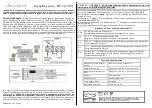
TC1796
System Units (Vol. 1 of 2)
General Purpose I/O Ports and Peripheral I/O Lines
User’s Manual
10-11
V2.0, 2007-07
Ports, V2.0
Depending on the assigned pad class, the 3-bit wide pad driver mode selection bit fields
PDx in the pad driver mode registers Pn_PDR make it possible to select the port line
functionality as shown in
. Note that the pad driver mode registers are specific
for each port. Therefore, the Pn_PDR layout is described for each port in the port-
specific sections.
Class A1 pins make it possible to select between medium and weak output drivers. Class
A2 pins make it possible to select between strong/medium/weak output drivers. In the
case of strong driver type, the signal transition edge can be additionally selected as
sharp/medium/soft.
Note: Please refer to the TC1796 Data Sheet for detailed DC characteristics of class A1
and class A2 pads.
In addition to the pad driver mode register control selections, a temperature
compensation logic, which is a part of the system control unit (SCU), makes it possible
to adjust the edges of the high-speed class A2 GPIO output lines depending on the die
temperature. The temperature compensation logic affects all class A2 GPIO output lines
that are used simultaneously as output.
The fully programmable temperature compensation logic provides four types of output
driver levels:
•
Maximum level (low temperature)
•
High level
•
Low level
•
Minimum level (high temperature)
Table 10-4
Pad Driver Mode Selection
Pad Class
PDx.2
PDx.1
PDx.0
Functionality
A1
X
X
0
Medium driver selected
1
Weak driver selected
A2
0
0
0
Strong driver, sharp edge selected
1)
1) In strong driver mode, the output driver characteristics of class A2 pads can be additionally controlled by a
temperature compensation logic (see
).
0
0
1
Strong driver, medium edge selected
0
1
0
Strong driver, soft edge selected
0
1
1
Weak driver selected
1
0
0
Medium driver selected
1
0
1
1
1
0
1
1
1
Weak driver selected
















































